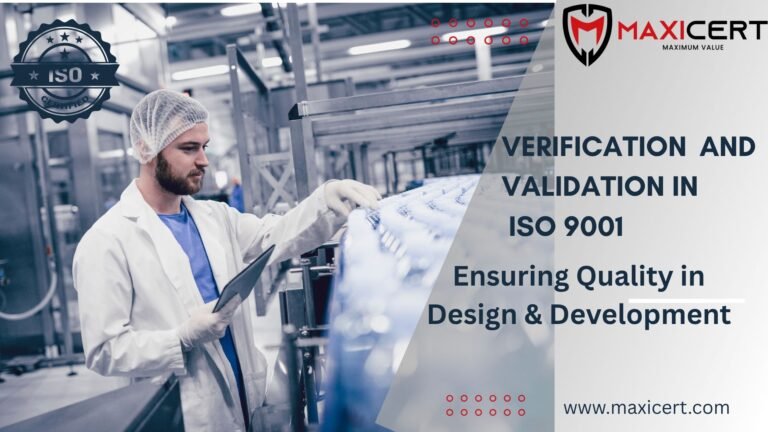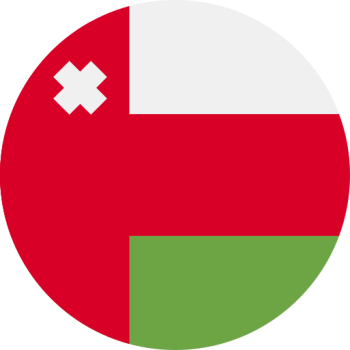Verification and Validation in ISO 9001: Ensuring Quality in Design & Development

Introduction
In ISO 9001 certification, verification and validation play a crucial role in the design and development process, ensuring that products and services meet customer expectations and regulatory requirements. Clause 8.3.3 outlines the importance of gathering and reviewing design inputs, while Clause 8.3.4 emphasizes effective controls, including verification and validation, to guarantee quality and compliance. These steps are essential for organizations aiming to achieve ISO certification, as they directly impact the development of a robust and reliable quality management system. Maxicert supports businesses in implementing these ISO 9001 processes effectively, helping them meet international standards and maintain consistent quality.
According to Clause 8.3.3 of ISO 9001-Design and development inputs
Inputs for design and development should be determined at the first stage of the process.
A major consideration is the customer’s needs, which may not always be clearly stated. It is often just as important to be aware of the customer’s unstated expectations, which could be even more critical to the design and development. The review might result in additional information to be considered. Other factors that could need to be considered include the following:
Request A Free Quote
- industry practice and standards,
- necessary resources such as technologies, personnel, equipment, etc.
- past nonconformities of products and services and past information of complaints.
- Information derived from previous similar designs
There needs to be a check to make sure that none of these inputs conflict. Such as determining the priority of performance enhancement or environment-friendly.
Inputs for design and development should be retained as documents, records, or any other objective evidence. Information for the production method
- Information for maintenance and inspection
- Information about the supplier
- Design criteria (include packaging)
- technical criteria
And also, it is necessary to determine the following inputs:
- statutory and regulatory requirements relating to the product and service (e.g. environmental considerations or health and safety requirements),
- other legal requirements,
- market surveys,
Possible to use at later verification activities.
8.3.4 Design and development controls
The control of the design and development activities that have been determined and planned by 8.3.2 should ensure that the processes final output is clearly defined and the necessary review, verification, and validation are carried out.
Defining final output of the activities
In general, pursuing the performance of products and services often deviates from what customers really require, such as user-friendliness.
Therefore, the importance of control in design and development lies in ensuring that personnel always understand the final output and its purpose, thereby realizing the customer’s requirements.
Review
Design and development review is the formal checking of the design and development planning stages and the output of each of those stages to confirm their adequacy to meet the input requirements, to identify problems, and to develop solutions.
Other people may be included in the design review, not just the person or people who did the design and development, but also the key people who will be involved in producing the product and service. This should include not only the people within the ed organization but, where relevant, those outside such as the customer and any suppliers involved.
If the review reveals problems, you will need to decide what actions of are to be taken to deal with these. The effect of the actions should be part of the next review.
Verification
Verification
Verification is checking that the results at the end of the design process meet the requirements identified as necessary at the beginning of the design and development process. For larger projects, the design and development process are often broken into stages and design and development verification may be carried out on a stage-by-stage basis.
The design and development plan should identify the verification method to be used, including who is to carry it out, how it is to be performed and what records are to be kept. There are many ways to verify the design and development, such as:
- performing alternative calculations,
- comparing the new design and development with a similar proven design and development (if available),
- undertaking tests and demonstrations, and
- checking the design and development stage documents before release.
You should determine which are appropriate and effective. Sometimes, regulatory bodies will describe the means required to verify the design and development.
Where verification shows that the output does not match or meet the input specification, you will need to decide what to do about it. The effect of any actions that you decide upon should form part of the next design and development review.
If specified in the customer’s order, you will need to include the customer in the verification process.
Validation
Validation is the process of checking that the final product and service will be capable of meeting or does meet the customers’ needs when applied in the intended environment.
Where validation indicates that the end product and services does not meet the needs as outlined above, you will need to decide what you are going to do about it. The effect of any actions that you decide will need to be part of the next design and development review.
This could include marketing trials or operational testing. It is the final stage in the design and development process and is an important opportunity to prevent serious financial loss by failure to supply an acceptable product and service.
The results of the verification and validation processes should be fed back into each stage of the design and development process, as this can lead to modifications and improvements (or even into the next design and development revision, or next generation of the product and service).
For many products and services validation can be a relatively simple process. One example is a new design and development of garden furniture which could be validated by testing of the prototype, followed by test marketing.
For other types of products and services, the validation of the total performance range might not be achieved until the actual conditions occur. The performance at the extremities of the design and development range might never be validated, e.g. if they are based on once-in-100 years occurrence. For example, the anti-earth quake features of the building under maximum conditions are difficult to validate until those extremes actually occur.
It is possible in some cases that the review, verification and validation are consolidated in one event. If the verification occurs as part of the review process or if the verification and validation happen simultaneously, it is not necessary to overburden the process by repeating activities that create no value.
In some cases, the product and service are the design and development itself and validation is complex, for example, the outputs from designers or design consultants. In such cases, customer acceptance of sketches, scale models, or virtual reality simulations of the finished product and service may be used to demonstrate compliance with the requirements for validation.
It is also acceptable for the customer to perform the validation and to provide feedback of the results to the designer.
Conclusion
Verification and validation are essential steps in ISO 9001 design and development, helping businesses minimize risks, improve product quality, and meet customer needs. By systematically reviewing inputs, verifying design accuracy, and validating final outcomes, organizations can enhance efficiency and ensure compliance. A well-structured process not only prevents costly errors but also strengthens overall quality management.

Get In Touch

Get In Touch

Get In Touch
Need A Free Estimate?
Get a free consultation and Checklist to get certified for ISO , HALAL, CE Mark Certification.
FAQ
What is the difference between verification and validation in ISO 9001?
Verification ensures the design meets specified requirements, while validation confirms that the final product meets customer needs in real-world conditions.
Why is design and development control important in ISO 9001?
It ensures that the process is structured, with reviews, verification, and validation at every stage to maintain quality and compliance.
How can a company effectively verify and validate a design?
Methods include testing prototypes, alternative calculations, customer feedback, and real-world performance evaluations.



